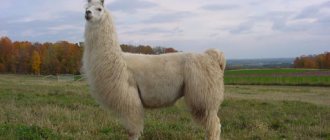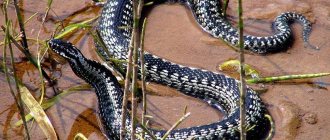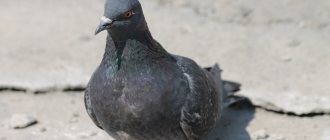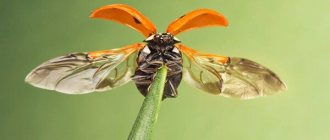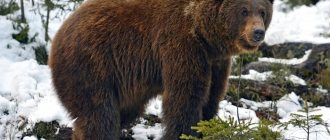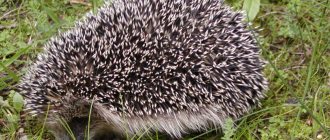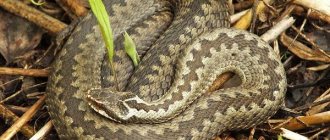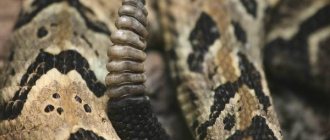- Wild animals
- >>
- Reptiles
The viper is one of the most dangerous and insidious snakes, the venom of which is second only to that of the cobra; it belongs to the viper family, is very large in size, because it is related to the genus of giant vipers. Let's try to analyze in detail her appearance, habits, and character to find out whether she is really as insidious and formidable as they say about her?
Origin of the species and description
Photo: Gyurza
The viper is a dangerous, poisonous snake, the largest representative of the viper family. The viper has many names and nicknames; it is often called the Levant viper. The word “gyurza” itself comes from the Persian language and translated from it means “mace” or “iron club”. This name has taken root behind the snake, thanks to its powerful muscular body, similar to a real club.
The name of the snake is translated from Latin as “coffin viper.” The Uzbek people call it a green snake, and the Turkmen people call it a horse. No matter how or where it is called, one thing is absolutely clear - it is very dangerous, poisonous and has an impressive size.
Video: Gyurza
On the territory of the former Soviet Union, this is the most dangerous and largest snake, all of its viper relatives are poisonous, but the viper is the most poisonous of them, as it is recognized not only in our country and the former countries of the USSR, but throughout the world. Now herpetologists have identified 6 subspecies of this dangerous reptile, but one of them remains in doubt. All varieties differ not only in their habitat, but also in size and some external features.
Describing the viper, it can be noted that it is of very large dimensions, which can reach a length (including the tail part) of up to 2 m, and a weight of about 3 kg. The viper's body is strong and powerful; its girth can be larger than a human arm. The skin color of different subspecies differs, it all depends on the snake’s permanent habitat.
The venom of the viper is so dangerous and strong that it has almost the same strength as that of the Asian cobra. Once in the human blood, the poison begins to destroy its red blood cells. And any delay could result in death.
Interesting fact: about 15 percent of all viper bites are fatal if left untreated. As an antidote, doctors introduce a special serum into the body, each time warning that independent treatment must be avoided, because it can be fatal.
Every year, several thousand people suffer from viper bites all over the world, so you need to know what appearance the tomb viper has in order to avoid becoming its victim.
Nutrition
On the menu of the mature viper, rodents lead the list, followed by birds and amphibians. Pikas, gerbils, mice, hamsters, ground squirrels, less often lizards and other snakes. Larger game, such as a hare, can become its prey.
Small turtles and their eggs are present in small quantities in the diet. She usually goes hunting during the day, but in the hot season, her activity changes. In summer they hunt in the morning and late afternoon, starting at dusk.
The snake begins active hunting in the spring. She chooses different places for this. It can hide on the slope of a mountain, can climb onto a bush, hide there and wait for prey - birds or chicks. Buntings and wagtails become victims of such hunting.
He likes to hide in vineyards, as there are many passerines and other birds there that fly to the sweet berries. Newborn snakes eat insects and small lizards. There have even been cases of cannibalism among these snakes.
By introducing a lethal dose of toxins, the poisonous viper not only paralyzes the victim, it starts the process of destruction of blood and other tissues, which occurs very quickly. In fact, she swallows half-cooked food. The snake is able to endure a hunger strike, sometimes long, but, having gone on a successful hunt, it eats up to 3 rats one after another.
Appearance and features
Photo: Viper snake
Despite the fact that there are specimens of snakes reaching two meters in length, the average body length of the viper is just under one and a half meters. The head of the viper has the shape of a triangle, and the whole body is very powerful and muscular. Small scales are visible above the eyes of the viper, this distinguishes it from its relatives. Other godyukovs have small shields on their heads; the viper has rough scales covering its head. The reptile's pupil is located vertically, and its muzzle is slightly rounded.
The color of the snake's head is monochromatic, there is no pattern on it. The color scheme of the entire body can be different, it depends on the variety and the places where the snake lives.
The overall tone of the skin can be:
- Light gray;
- Reddish-brown;
- Brown;
- Grey-beige;
- Dark gray;
- Black (sometimes with blue).
The pattern on the skin of the body differs among different subspecies, but usually these are spots of a darker color that are located on the back and sides. These spots have a brown tint with a touch of some rust; on the sides of the snake they are much smaller than along the ridge.
The snake's belly is always a lighter shade, which also has a spotted pattern. It should be noted that the spots decorating the snake’s body are not very contrasting, and therefore the pattern on the skin is not so bright. Not all Levantine vipers are decorated with a pattern; there are snakes of a single color, often they are brown or even black.
If a snake bites
If a snake accidentally disturbed by a person attacks, then a bite of a poisonous species can be distinguished from a safe one by the characteristics of the mark left on the skin. When bitten by a poisonous snake, a sufficiently deep puncture is formed from a pair of teeth. Non-poisonous reptiles leave a mark in the form of two rows of small and barely noticeable punctures or a couple of scratches. Such bites, as a rule, do not pose a serious danger, but the wounds must be treated with any antiseptic composition, and then protected from external influences with a plaster.
When bitten by a viper, viper or copperhead, it is necessary to provide complete rest to the affected limb, which will slow down the spread of toxins throughout the body. The poison is squeezed out of the wound immediately after the bite, and if necessary, the wound is widened, making it possible to remove a significant part of the dangerous toxin through the blood. Then the bite site is thoroughly disinfected with an antiseptic and a sterile bandage is applied. The victim should be taken as quickly as possible to the nearest medical facility, where a full range of medical care will be provided and a special, highly specialized antidote will be administered.
Where does the viper live?
Photo: Viper animal
The distribution area of the viper is very wide. The snake lives in such North African countries as Tunisia, Morocco and Algeria. The Levant viper also settled on some islands located in the Aegean Sea. The viper lives in the east of Asia Minor, in Syria, Palestine, Iraq, Jordan, Iran, and Arabia. The reptile's permanent place of residence is the Transcaucasian republics, with the exception of Abkhazia, where you will not find the viper.
The snake also fell in love with Central Asia, Afghanistan, and northwestern India. The Transcaucasian viper lives in our country. She settled in the southeastern part of Dagestan, she is listed in the Red Book of Russia. A very small number of vipers remain in Kazakhstan.
Gyurza loves the following landscapes:
- Deserts;
- Semi-desert area;
- Foothills;
- Lower belt of mountain ranges.
Interesting fact: the Levant viper can climb mountains up to 2.5 km high (in the Pamirs).
The viper finds its shelters in rocky crevices, under large stones. You can meet a dangerous reptile in river valleys, vineyard thickets, and near mountain streams. You should not be afraid of meeting a viper in the forest; it prefers open areas.
The viper is not very afraid of people, so it can be seen in gardens, melon fields, and cultivated lands, which is not typical for its other viper relatives. The two most important factors that influence a snake’s choice of a particular place of residence are the presence of nearby water and the abundance of food.
Poisonous snakes: varieties
The common viper (almost everyone knows it) lives in almost all territories of Russia. We can find it in any area: in forests, mountains, steppes, fields, swamps and meadows. This is one of the few snakes that can live even in cold climates.
The black mamba is also a type of poisonous snake - incredibly dangerous and deadly, considered one of the most insidious snakes in the world. It got its name because of the dark color of the inside of the mouth (blue-black). This is a fast, aggressive and deadly poisonous snake. It lives in the savannas and rocky hills of Africa (southern and eastern parts). It is the longest African venomous snake (up to 4.5 meters).
What does the viper eat?
Photo: Poisonous viper
The menu of different subspecies of viper differs, because... The areas of its habitat and the presence of this or that living creature in the inhabited territory are also different. In some areas, the snake menu consists mainly of all kinds of rodents, in others - from birds. The birds are eaten by reptiles that have settled in Central Asia.
In the viper menu you can see:
- Common house mice;
- Gerbils;
- Vole mice;
- Jerboas;
- Khomyakov;
- Young hares will be born;
- Hedgehogs;
- Small turtles;
- Geckos;
- Various lizards;
- Insects;
- Polozov;
- Yellowbellies;
- Baby porcupine.
This is how varied the diet of this most dangerous snake is. It should be added that only a very hungry viper attacks reptiles; it does this when it cannot find other prey. The viper hunts birds from an ambush located near the water. Birds that come to drink often become victims of a snake, which pounces with lightning speed and bites the victim with sharp teeth. Sometimes the bird manages to escape, the viper does not pursue the victim, who soon falls, struck on the spot by a strong poison.
An interesting fact: having swallowed its prey whole, the viper lies in the shelter in such a way that the part of the body where the prey is located is located under the sun's rays. A satiated snake lies motionless for several days so that the swallowed food is successfully digested.
It should be noted that the viper, which has settled on cultivated land, provides enormous benefits to humans, destroying many rodent pests.
Hunting
The viper is a snake that is an excellent hunter. On the ground or on some stone, it waits for its prey, and when it approaches, the viper makes a sharp, lightning-fast lunge. Having grabbed it, it does not let go of the prey, but waits for the poison to take effect, and then swallows it. Since these snakes have a very good appetite, a short time after eating food they continue their hunt.
Gyurza, like most snakes, loves to swim, while at the same time catching birds arriving at a watering hole.
Features of character and lifestyle
Photo: Viper snake
The viper comes out of hibernation in March-April, when the ambient temperature exceeds ten degrees plus. The males are the first to emerge from the den, and a week later the females also crawl out. Snakes that have woken up from hibernation are not in a hurry to go hunting immediately; first they take sunbaths. During the May period, reptiles often descend from the mountains closer to moist meadows and lowlands.
Usually, a large number of vipers accumulate near rivers and springs; snakes love swimming and consume a lot of water. With the onset of summer heat, the viper switches to the twilight mode, at which time its hunting forays begin; hunting can occur both at night and at dawn. Sharp vision and an excellent sense of smell easily help to find prey in pitch darkness. In the heat, snakes hide under stones, in the shade of grass, in gorges. In spring and autumn, hunting also occurs during the day.
An interesting fact: with the arrival of November, the viper crawls to their winter dens to go into hibernation again; they do this either alone or as a whole group (about a dozen individuals).
There are many rumors about the cunning of the viper. Perhaps it lies in the fact that she does not warn about her poisonous throw, catching her ill-wisher by surprise. If a cobra puffs up its hood and hisses threateningly, then the viper does not show it until the last minute, hiding in ambush, and then suddenly pounces. In vain, many believe that due to its large size it is clumsy; even seasoned snake catchers sometimes did not have time to dodge its swift throw, the distance of which reaches the length of the body of the viper itself.
The viper has many talents - it climbs trees very well, crawls quickly on the ground, can jump high, and has colossal strength. Not every snake catcher is able to hold this reptile in his hands, because it fiercely resists. When the viper breaks out, it can even sacrifice its lower jaw, biting through which it tries to hook a person.
Separately, it is worth mentioning the molting of the viper, which happens three times a year. Newly born cubs molt a few days after birth, and young individuals molt about eight times over a one-year period. For successful shedding, environmental conditions such as humidity are important, so snakes most often shed early in the morning or after rain.
Interesting fact: if there is no rain for a long time, the viper has to soak in dew, in damp soil, or climb into a pond to soften the scales and easily shed them from the body.
At the moment of molting, the snake makes a lot of efforts to free itself from the old skin. She tries to crawl between the stones. At the end of this process, the reptile lies for about a day without moving, apparently gaining strength.
If you are bitten by a snake
If a steppe viper does come across your path, it is best to freeze and wait until it crawls away on its own. If a “collision” does occur, the bite can be either very painful or barely noticeable. Signs of a bite may include hemorrhagic blisters, rapidly increasing swelling, nausea, drowsiness, dizziness, rapid and uneven heartbeat, increased body temperature, pressure surges, and traces of blood may be observed in the urine.
What to do if you are bitten by a steppe viper? First of all, don't panic. From fear and panic, blood pressure rises, which contributes to the rapid absorption of poison by the body. Therefore, it is necessary to try to squeeze out or suck out the poison before the swelling begins to spread. It is worth saying that the effectiveness of this action is highest in the first 1-2 minutes. After each suction, you need to rinse your mouth with at least water, and preferably a solution of potassium permanganate. The wound should be treated with an antiseptic and a tight sterile bandage should be applied to it.
It is also very important to immobilize the person in order to prevent further spread of the poison through the blood. After this, it is extremely important to take measures to neutralize the poison - give the victim plenty of fluids
This can be water or tea, preferably green, in a volume of 1.5-3 liters. Alcohol in any form and the application of a tourniquet are contraindicated. After this, the person should be transported to a hospital as soon as possible, where he will be provided with qualified medical care.
Social structure and reproduction
Photo: Gyurza
Levant vipers become sexually mature when they reach 3–4 years of age. Their mating season begins at different times, depending on the climate of a particular area, but most often it occurs in April-May.
An interesting fact: before the viper mates, something like love games occurs, when two snakes, intertwining with each other, wriggle and stretch upward.
It should be noted that not all vipers are oviparous; there are also ovoviviparous reptiles. Snakes usually lay eggs in July or August; the clutch can contain from 6 to 43 eggs, this is influenced by the size of the female. The weight of one egg is from 10 to 20 grams, and its diameter can reach from 20 to 54 mm. Eggs are laid in holes left by someone, in rock crevices; the incubation period lasts about 50 days. For successful development of embryos, there must be moderate humidity, then the weight of the eggs increases. Strong dampness can cause harm, causing mold and death of the embryo.
Usually at the end of August or at the beginning of September the offspring hatch. Little snakes are born already formed and completely independent. Their length reaches 28 cm, and the babies weigh about 12 g. At first, the babies eat all kinds of insects, gradually starting to catch heavier victims. In natural conditions, the viper usually lives no more than one dozen years, and in captivity - twice as long.
Names and characteristics of drugs based on viper venom
Ointments for joints based on viper snake venom have a local irritant and anesthetic effect due to irritation of superficial sensitive nerve endings in the skin and underlying tissue. Their influence is accompanied by vasodilation and blood flow, thereby improving tissue trophism.
In its pharmacological effect, viper venom is similar to other locally irritating components (turpentine, camphor) in that it dilates blood vessels. Therefore, in the ointment they are contained in a complex to enhance each other’s effect. In addition, it contains hyaluronidase, which promotes the resorption of hematomas and scar tissue in the joints and improves their mobility. And the neurotoxic component has an analgesic effect.
Viprosal B
Ointment with viper venom for joints Viprosal B is a complex preparation. Contains additional turpentine, camphor and salicylic acid. The complex of locally irritating components produces a distracting effect due to burning of the skin. And salicylate has an anti-inflammatory and keratolytic effect. Vasodilation under the influence of the ointment leads to improved trophism in tissues and their rapid restoration. The advantage of the ointment is its natural composition, rapid absorption and affordable price, but some patients say the smell is too strong.
Salvisar
This ointment has an identical composition to Viprosal B with minor differences in the excipients. But if Viprosal B is produced in Latvia and Estonia, then Salvisar is a Russian drug and costs a little less.
The ointment should be applied 1-2 times a day, 5-10 g, which corresponds to 1-2 teaspoons, gently rubbing into the skin.
The duration of therapy without consulting a doctor is no more than 10 days. The appearance of burning and redness after applying the ointment is a normal local reaction that should subside within a few minutes after application. If the symptoms are too pronounced and persist for a long time, it is better to remove the ointment from the skin.
This snake venom ointment for joints is contraindicated for pregnant women and children under 6 years of age. From 6 to 18 years of age it should be used with extreme caution. In addition to standard contraindications for all local irritants, Salvisar is prohibited for use in aspirin-induced bronchial asthma.
When combined with other local drugs, it is worth considering that Salvisar ointment, due to vasodilation, can enhance their effect. When used together with methotrexate, the ointment may increase its toxicity. And when used simultaneously with hypoglycemic drugs, Salvisar reduces their effect.
Video: Salvisar ointment for leg pain
This video describes the benefits of Salvisar ointment, indications for use and its effectiveness for pain syndrome. SubTatiana about Salvisar ointment - an effective remedy for pain in muscles and joints
Natural enemies of the viper
Photo: Gyurza from the Red Book
The viper has considerable dimensions, is very swift, lightning fast, dangerous and poisonous, so many animals avoid communicating with it, especially attacking the reptile, but there are also those who like the viper. Among them, the most dangerous enemy for the viper in natural conditions is the monitor lizard.
The thing is that the strong and toxic poison of the viper has absolutely no effect on it, the monitor lizard is not susceptible to it, and therefore is not afraid to attack the Levantine viper. Sometimes a wolf, a jungle cat, a fox, or a jackal can attack a viper. Of course, these mammals risk their lives, because they do not have an antidote. Animals usually attack during difficult, hungry periods, when they cannot find other prey.
In addition to terrestrial animals, some birds also hunt viper, attacking from above, directly on the fly. Birds such as darter eagle and steppe buzzard usually do this. Young animals, which are not yet a year old, often suffer from attacks by other reptiles (sand ephesus, Central Asian cobra). Inexperienced snakes are also overcome by the desert monitor lizard.
They can also be attacked by birds such as the Buzzard and the Black Kite. If young vipers notice any threat, they immediately try to hide and run away. When escape is impossible, the reptiles begin to attack, making rapid attacks that extend more than a meter. Often this helps to escape, because Levant vipers are not only poisonous, but very strong and powerful.
Danger to humans
Although Ephs are considered one of the deadliest snakes, more than half of the attacks on people occur due to their own carelessness and improper behavior when encountering these reptiles. The Efa snake attacks a person only if it feels that there is danger towards it or its offspring
She herself avoids people and never approaches dwellings.
You can tell that a snake is preparing to attack by the way it wriggles. Having formed two bends with her body, Efa holds her head under the cover of one of them, ready to attack at any second. At the same time, she does not freeze, like other poisonous snakes, but is in constant motion in order to make a throw and bite into the enemy as soon as he is within her reach. Efa is capable of making vertical jumps to a height equal to half the length of her body. If you accidentally meet her, you should keep a distance of at least 3 meters. At such a distance there is still a chance to escape
If a characteristic sound comes from the snake (it is created by the friction of the side scales) - this is a sign that while it is in a defensive position, there is still time to carefully step back, while remaining facing it, and leave
These snakes are not kept in captivity, both because they are dangerous and because they are very restless and cannot tolerate confined spaces. As practice has shown, in the serpentariums where experts tried to keep them, Ephs live no longer than a year.
https://youtube.com/watch?v=jp32ya4GE2c
Population and species status
Photo: Gyurza in Russia
The habitat of Levant vipers is quite wide and diverse. At the moment, various organizations involved in the protection of animals and nature at the international level claim that the number of vipers is not in danger; there are a lot of these snakes in almost all territories where they have permanent residence. Digital calculations made by scientists also correspond to this statement.
They show that in the usual place of permanent location of the viper there are four individuals per hectare, and in the hot summer, up to twenty pieces per hectare gather near various water bodies. As a result of these data and other studies, there are no concerns about the population size of the viper, there are no threats of extinction, but this is not the case everywhere.
In some countries, the viper population is very small. This happened as a result of the development of rapid human agricultural activity and mass snake catching. It is no secret that viper venom is used in pharmaceuticals, making some medicines from it that help with rheumatism, radiculitis, and hemophilia.
Ill-considered human actions have led to the fact that in Russia and Kazakhstan the viper is listed in the Red Book. It is good that such a small state of the population is local, but in other regions the viper feels great and is not subject to the threat of destruction.
General indications
Snake venom for joints in ointments is used for a number of diseases of the joints and surrounding tissues (muscles, tendons and ligaments). These include inflammatory processes, dystrophy, trauma, autoimmune pathology and pain syndromes of various origins .
The main ones:
- injuries: bruises, sprains, dislocations;
- arthritis, including rheumatoid;
- osteochondrosis;
- arthrosis;
- joint pain;
- gout;
- paresthesia, numbness of the back, shoulders;
- myositis (inflammation of skeletal muscles);
- bursitis, synovitis;
- myalgia (muscle pain of various etiologies);
- neuritis (inflammation of the peripheral nerve);
- neuralgia (pain along the nerve trunk);
- radiculitis (inflammation of the spinal nerve roots);
- sciatica (pain spreading along the sciatic nerve);
- lumbago (lumbago in the lower back).
General contraindications
The use of joint ointment with snake venom is contraindicated for:
- hypersensitivity to any of the components;
- contact dermatitis and infectious skin lesions;
- ulcerative lesions and skin injuries;
- tendency to seizures;
- fever;
- tuberculosis;
- severe liver and kidney failure;
- peptic ulcers of the gastrointestinal tract (stomach, duodenum, colon);
- severe liver and kidney failure;
- tendency to bronchospasm;
- whooping cough;
- bronchial asthma;
- disturbances of cerebral circulation and spasms of cerebral vessels;
- pregnancy and lactation;
- children under 12 years of age;
- severe exhaustion of the body.
Combination medications
There are ointments containing toxins from several snakes at once. They have a more pronounced and varied effect. Although allergic reactions to such drugs are detected more often.
Kapkotoks
The Vietnamese cream Kapkotoks contains the venoms of three snakes at once: the king cobra, the green boiga and the white-lipped keffiyeh. It is characterized by an almost instantaneous and strongly pronounced analgesic effect. In addition, this ointment for joints contains methyl salicylate, which has an anti-inflammatory effect, and menthol, which irritates and at the same time cools the skin.
You need to apply the ointment up to 3 times a day, rubbing it in with massaging movements. Course of treatment – 7–10 days .
Its use is contraindicated for children, pregnant and lactating women. Avoid application to damaged skin, mucous membranes and accidental contact with the eyes. The advantages of the drug are fast and strong pain relief, good absorption and an affordable price.


